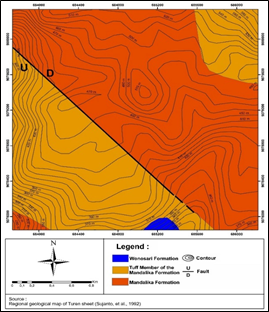The Analysis of Pyrophyllite Quality as a Potential Industrial Raw Material in Argotirto Area, Sumbermanjing Wetan District, Malang Regency, East Java, Indonesia
DOI:
https://doi.org/10.25299/jgeet.2024.9.3.10153Keywords:
Pyrophyllite, Sumbermanjing Wetan, XRD, XRF, Pyrophyllite QualityAbstract
The Argotirto area, Sumbermanjing Wetan District, Malang Regency, East Java is one of area which had industrial mineral, namely pyrophyllite. Pyrophyllite minerals in this area were generally found in rocks that have been altered by hydrothermal alteration. Pyrophyllite is an industrial mineral that can be used as a raw material in various industries.
This research aims to determine the geological conditions, physical properties, mineralogical and geochemical properties of pyrophyllite in the research area and to determine the quality of pyrophyllite as a potential industrial raw material. The methods used in this research were megascopic analysis, petrographic analysis, X-Ray Diffraction (XRD) analysis, and X-Ray Fluorescene (XRF), and the quality assessment of pyrophyllite using the standard of PT Gunung Bale, SNI No. 15-1023-1989, and SNI No. 15-1325-1989.
The lithology in the study area consists of basaltic lava, andesite breccia, dacitic tuff breccia, dacite intrusion, and limestone. Pyrophyllite in the study area has a quality ranging from low grade to high grade. The EIP sample is classified as high grade quality and can be used as raw materials for the refractory industry, class I refractory materials, and materials for making fine ceramics. The WSP sample is classified as medium grade quality, and can be used as class III refractory materials. The DSP sample is classified as low grade quality, and can be used as a class III refractory material.
Downloads
References
li, M. A., Ahmed, H. A. M., Ahmed, H. M., & Hefni, M. (2021). Pyrophyllite: An economic mineral for different industrial applications. Applied Sciences (Switzerland), 11(23), 1-18,
Anggraini, R., (2008). Pengaruh Penambahan Phyropilit Terhadap Kuat Tekan Beton. Jurnal Rekayasa Sipil 2(3), 163 – 174.
Arbio, C., Layne, G. D., Zanoni, G. and Secvic, B., (2021). Characteristics and genesis of phyllosilicate hydrothermal assemblages from Neoproterozoic epithermal Au-Ag mineralization of the Avalon Zone of Newfoundland, Canada. Journal Applied Clay Science 202,
Badan Standarisasi Nasional. (1989). Batuan piropilit untuk pembuatan barang tahan api. Jakarta. Retrieved September 9, 2022,
Badan Standarisasi Nasional. (1989). Batuan piropilit untuk pembuatan keramik halus. Jakarta. Retrieved September 9, 2022,
Badan Standarisasi Nasional. (2011). Pedoman Pelaporan, Sumberdaya, dan Cadangan Mineral. Amandemen 1-SNI-13-4726-2011., 32.
Charalampides, G., Vatalis, K. I., Platias, S., & Karayannis, V. (2014). The Contribution of Industrial Minerals to Sustainable Recovery of Greek Economy. Procedia Economics and Finance, 14(14), 128–136.
Chen. (1977). Table of reference for identification of miner.pdf.
Heryono, P. (1997). Penelitian Skala Laboratorium Potensi Batu Pirofilit Di Desa Karanggede, Kecamatan Arjosari, Kabupaten Pacitan, Provinsi Jawa Timur Dan Prospek Pengembangannya. Media Teknik, 19, 10-17.
Li, G., Zheng, J., Luo, J., Liu, M., Jiang, T. and Qiu, G. (2014). Thermal Transformation of Pyrophyllite and Alkali Dissolution Behavior of Silicon. Journal Applied Clay Science 99, 282-288
Mackenzie, K. J. D. (2009). Utilisation of Non-Thermally Activated Clays in The Production of Geopolimers. Woodhead Publishing, 294-314.
Mutrofin, S., Setyaningsih, T. and Susilo, A., (2006). Karakteristik Piropilit dari Sumbermanjing Malang Selatan. Jurnal Natural, 10(1), 1-7.
Novianto, I. (2012). Pengaruh Variasi Penggunaan Piropilit dan Jenis Semen Terhadap Porositas dan Modulus Elastisitas Beton. (thesis).
Öner, F., & Taş, A. (2013). Geochemistry, mineralogy and genesis of pyrophyllite deposits in the Pötürge Region (Malatya, Eastern Turkey). Geochemistry International, 51(2), 140–154.
PT Gunung Bale. (2021). Product PT Gunung Bale-Indonesia.
Prasetya, H., (2012). Pengaruh Penggunaan Pyrophyllite Dan Jenis Semen Terhadap Kuat Tekan dan Regangan Beton. (dissertation).
Rollinson, H. R. (2014). Using Geochemical Data: Evaluation, Presentation, Interpretation. Roudledge, New York, 384 pp.
Travis, R. B. (1955). Classification of Rocks, Volume 50. Colorado School of Mines, 98 pp.
Sujanto, Hadisantono, R., Kusnama, Chaniago, R. and Baharuddin, R., (1992). Peta Geologi Lembar Turen No. 1607- 4, Pusat Penelitian dan Pengembangan Geologi, Bandung, skala 1:100.000.
Yuwanto, S. H. and Solichah, L., (2015). Studi Alterasi dan Mineralisasi Daerah Tambakasri dan Sekitarnya, Kecamatan Sumbermanjing Wetan Kabupaten Malang, Provinsi Jawa Timur. Seminar Nasional Sains dan Teknologi Terapan III, 2015, Institut Teknologi Adhi Tama Surabaya, 519-526, ISBN: 978 602 98569 1 0.

Downloads
Published
Issue
Section
License
Copyright (c) 2024 Journal of Geoscience, Engineering, Environment, and Technology

This work is licensed under a Creative Commons Attribution-ShareAlike 4.0 International License.
Copyright @2019. This is an open-access article distributed under the terms of the Creative Commons Attribution-ShareAlike 4.0 International License which permits unrestricted use, distribution, and reproduction in any medium. Copyrights of all materials published in JGEET are freely available without charge to users or / institution. Users are allowed to read, download, copy, distribute, search, or link to full-text articles in this journal without asking by giving appropriate credit, provide a link to the license, and indicate if changes were made. All of the remix, transform, or build upon the material must distribute the contributions under the same license as the original.










